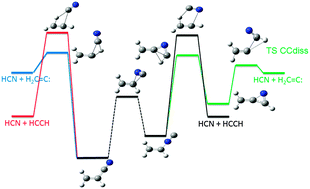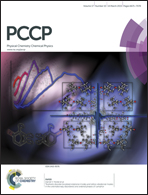HCN elimination from vinyl cyanide: product energy partitioning, the role of hydrogen–deuterium exchange reactions and a new pathway†
Abstract
The different HCN elimination pathways from vinyl cyanide (VCN) are studied in this paper using RRKM, Kinetic Monte Carlo (KMC), and quasi-classical trajectory (QCT) calculations. A new HCN elimination pathway proves to be very competitive with the traditional 3-center and 4-center mechanisms, particularly at low excitation energies. However, low excitation energies have never been experimentally explored, and the high and low excitation regions are dynamically different. The KMC simulations carried out using singly deuterated VCN (CH2![[double bond, length as m-dash]](https://www.rsc.org/images/entities/char_e001.gif) CD–CN) at 148 kcal mol−1 show the importance of hydrogen–deuterium exchange reactions: both DCN and HCN will be produced in any of the 1,1 and 1,2 elimination pathways. The QCT simulation results obtained for the 3-center pathway are in agreement with the available experimental results, with the 4-center results showing much more excitation of the products. In general, our results seem to be consistent with a photodissociation mechanism at 193 nm, where the molecule dissociates (at least the HCN elimination pathways) in the ground electronic state. However, our simulations assume that internal conversion is a fully statistical process, i.e., the HCN elimination channels proceed on the ground electronic state according to RRKM theory, which might not be the case. In future studies it would be of interest to include the photo-prepared electronically excited state(s) in the dynamics simulations.
CD–CN) at 148 kcal mol−1 show the importance of hydrogen–deuterium exchange reactions: both DCN and HCN will be produced in any of the 1,1 and 1,2 elimination pathways. The QCT simulation results obtained for the 3-center pathway are in agreement with the available experimental results, with the 4-center results showing much more excitation of the products. In general, our results seem to be consistent with a photodissociation mechanism at 193 nm, where the molecule dissociates (at least the HCN elimination pathways) in the ground electronic state. However, our simulations assume that internal conversion is a fully statistical process, i.e., the HCN elimination channels proceed on the ground electronic state according to RRKM theory, which might not be the case. In future studies it would be of interest to include the photo-prepared electronically excited state(s) in the dynamics simulations.


 Please wait while we load your content...
Please wait while we load your content...